Seven household items that are better second-hand
Loading...
I admit it, I brake for estate sales. Nothing gets my Saturday morning juices flowing quicker than an old fashioned tag sale — the sort of event where the contents of an entire household are up for grabs.
Beyond the antiques and random curiosities, I love the hunt for bargain-priced practical items that have been used, loved, and well taken care of. These things aren't just good in spite of their age; they're better because of their age. Here's my list of seven common household items that are simply better second-hand.
1. Bath Towels
There's nothing worse than stepping out of a hot shower and trying to dry off with a towel that feels like a polyester pantsuit. Today, many manufacturers blend man-made fibers with cotton and chemically treat towels to make them appear fluffier on the shelf. Great for display, but terrible for absorbency.
Older towels are more likely to be 100% cotton and were either left untreated or they've been around long enough to have any finishing gunk washed away. Cotton also gets more absorbent with use, making older towels super-suckers worth their weight in gold. Get over the "ick" factor of using second-hand towels by washing them in hot water and color-safe bleach. Keep them thirsty by strictly avoiding fabric softeners — they coat the cotton fibers and reduce absorbency.
2. Cast Iron Cookware
Cooks spend years seasoning their cast iron pots, pans, and skillets. Be the beneficiary of all their time and hard work. Buy a great used set at an estate or yard sale and save some serious cash while you're at it.
3. Household Sponges
Large household sponges get softer and looser with age and do the job much better than new. I wash my car by hand and my favorite tool for the task is a big old sponge that belonged to my dad. It doesn't look like much, but it's a little treasure that just gets better year after year.
4. Wall Clocks
I must have missed the memo. When did we all decide that it's acceptable for wall clocks to last only a couple of years? Why have consumers lowered their expectation of quality and why do we keep replacing junk with junk? Generally speaking, older wall clocks (made in the 1970s or earlier) have higher quality internal clockworks. Many of them will last a lifetime.
5. Toasters
After burning through a new $25 toaster every couple of years, I finally got smart and bought a used one at an estate sale for $2. It was probably made in the mid-70s and has an understated chrome finish. I've owned it for 10 years now and it's as faithful as my dog.
6. Flatware
Yesterday's mid-level set of flatware is likely better quality than today's high-end set. Heavier gauge metal and better craftsmanship makes second-hand flatware first-rate.
7. Manual Can Openers
Okay, you've probably guessed that I'm a bit of a nerd about product dependability. With that in mind, let me wrap things up by venting about modern can openers for a minute: Most of them are electric, which renders them useless during a power outage. If you can even find the manual variety, beware — newer versions typically turn cans into mangled concept art and have flimsy plastic handles that snap under the slightest pressure.
The next time you're scouting for treasures at a yard sale, keep an eye out for vintage Swing-A-Way can openers. They're easy to find — people are dumping them like crazy in favor of sleeker looking options. Older models were made in America, crafted entirely of steel (seriously, they're built like tanks), and feature rubber-coated handles in a variety of colors. Snatch up a used one for $.50, keep it clean and dry, and never think about can openers again. You're welcome.
This article first appeared at Wise Bread.







